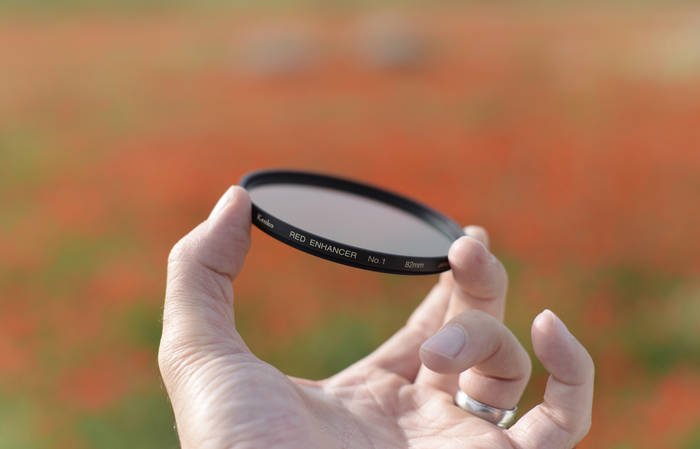
Title picture – Credit: Alireza Vafa
The advent of Digital photography and post processing tools strongly challenged the implementation of some photography filters. But there are many reasons which are carefully considered by professional photographers to keep using filters toward creativity and capturing unique photos. Kenko Red Enhancer filter’s effect and influence on picture are among those ones which is not possible to reproduce in post processing stage or with any settings or retouching tools.

Figure 1- Light transmittance of Kenko Red Enhancer No.1 filter. Credit: Kenko Global
As transmittance curve of this filter is shown in figure 1, Kenko Red Enhancer No.1 heavily blocked wave lengths between 560nm to 600nm due to the specific material it is made of: Didymium. By using this filter, the light changes its physical nature before reaching the sensor, so this selective blocking is out of reach for any post processing techniques.
In general, the results would be enhancing red color so that it appears much more vivid and saturated. As you can see on Picture 1, the red color of tulips exposed is much more prominent through the filter.

Picture 1- The effect of Kenko Red Enhancer No.1 on how to manipulate light in order to create rich red colors. Credit: Alireza Vafa
However, this particular manipulation of light passing through the specific mean of this filter could serve in a wide range of applications.
Nowadays, at night we make use of a wide range of different types of artificial lights to light cities and places and in fact these lights invade the beauty of night sky. Such lights emit photons in different wavelengths and distributions as shown in Figure 2.

Figure 2 – Spectral Power Distributions of Various Light Sources. Credit:lamptech.co.uk
The distribution of emitted lights by these lamps are different, but there is a specific range of wave lengths which is matching in all graphs; the Yellow-Orange region (570nm-600nm). Didymium, the material used in Kenko Red Enhancer filter targets exactly this part. As a result, this filter could also be used under artificial lights to produce different results.

Picture 2 – Under artificial lights, the true colors of subjects ruined due to uneven distribution of light spectra. This effect could greatly improve by Kenko Red Enhancer No.1 filter. Compare how this filter recover colors in the image of this ancient red Persian carpet which under artificial light. Left image captured with filter and the right one without it. Credit: Alireza Vafa
Moreover, blocking the most intense part of artificial lights assures a similar effect of a wide band light pollution reduction filter. Also, even when the vast utilization of Low and High pressure Sodium and Metal Halide lamps illuminate strongly the night sky on Yellow-Orange part of spectrum, the Red Enhancer filter is considered a great tool to eliminate light pollution and to create much more realistic and pleasant night scape photos.

Picture 3 – Night scape photographers have a great chance to control light pollution of night sky easily by using Kenko Red Enhancer No.1 filter. Bottom image is taken with filter and the top one without it. Both images are taken atthe same time and location and similarly post processed. The difference in colors and background lights are due to light pollution of a city at 40km away. Credit: Alireza Vafa
In conclusion, photography is the realm of creativity. I discovered that Kenko Red Enhancer No.1 filter is a dedicate tool in light manipulation, which is out of reach for computer post processing tools, and that the image of various subjects under different lightings could be further enhanced by using this filter. For instance, in portraits and even family pictures taken indoors under artificial lights, much better warm and natural skin tones and lively colors could be created by using Red Enhancer No.1 filter. I even apply this filter on some of my black and white photos, trying to discover the unique abilities of this filter on manipulating a special part of the spectrum! Such special effects will be researched and reviewed on our upcoming review articles.
Credit: Alireza Vafa
Alireza Vafa
www.alirezavafa.com
https://www.linkedin.com/in/alireza-vafa-4a619710b/
https://www.instagram.com/ali.reza.vafa/?hl=en
https://www.facebook.com/AV.alireza.vafa

